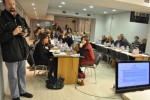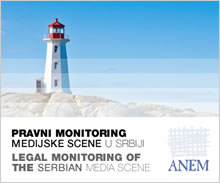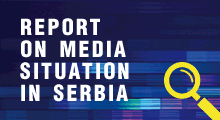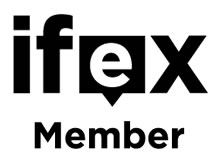27. 01. 2015
ANEM PRESENTED 11TH MONITORING PUBLICATION

The publication features articles about important media issues: Strategy for the Development of Radio and Audiovisual Media Services, censorship and self-censorship in the Serbian media, transparency of media ownership, and digitalization process in Serbia.
The event gathered some 50 representatives of media and media/journalists' associations, NGOs, responsible authorities, international organizations and donors, and other interested parties.
The round table was organized within ANEM project "Legal Monitoring of the Serbian Media Scene", successfully implemented for five years now. In 2014 the project is financially supported by Civil Rights Defenders and the Open Society Foundation, Serbia.
In the first part of the round table, the publication was presented by its authors: Milos Stojkovic of the "Zivković & Samardzic" Law Office, Belgrade (article: "Why Do We Need a Strategy for the Development of Radio and Audiovisual Media Services and What Should This Strategy Be"); Slobodan Kremenjak, attorney at law (article: "Censorship and Self-Censorship in the Serbian Media"); Davor Glavas, media expert (article: "Transparency of Media Ownership - Necessary, but is it Sufficient?"); and prof. Irini Reljin, PhD - School of Electrical Engineering, University of Belgrade and assistant minister at the Ministry of Trade, Tourism and Telecommunications (article: "Digitalization Process in Serbia").
After the presentation of articles, a discussion was opened by special guests - Branko Gogić, acting director of the public company for operating broadcasting infrastructure (JP ETV) and Radiša Petrović, special adviser with JP ETV.
Strategy for the Development of Radio and Audiovisual Media Services
Milos Stojkovic of the "Zivković & Samardzic" Law Office in Belgrade talked about the future process of passing the Strategy for the Development of Radio and Audiovisual Media Services that should be an accompanying document to the new media laws (adopted in August 2014) that set a new legal framework for the operation of the media sector. Stojkovic noted that the law does not envisage a precise deadline for the adoption of this document and thus it is not yet known when it will be adopted.
While the former Broadcasting Development Strategy, in effect until 2013, was entirely within the authority of the then Republic Broadcasting Agency (now Regulatory Body for Electronic Media - REM), draft of the future strategy is to be proposed by REM, but adopted by the Government of Serbia. The new strategy, unlike the former one, will be adopted following a market analysis, to be done in cooperation with the Regulatory Agency for Electronic Communications and Postal Services (RATEL) and the Commission for Protection of Competition (both have experience in market analysis), which means that more actors will be engaged in drafting of the new strategy than was the case with the former one. It is important to note that the said market analysis may not be reduced to economic indicators only since the protection of public interest in broadcast media is of great importance, Stojkovic said.
The former strategy was adopted in a non-transparent manner, Stojkovic noted, without properly consulting the expert public and without accepting (as it later turned out) justified suggestions of journalists' and media associations, which lead to some goals of the strategy being unrealistic and inappopriate. For that reason, it is important that the new strategy, before it is adopted, be subject to a broad consultation among the expert public, but also among the Serbian citizens (as the strategy has to address their needs) and minority groups, said Stojkovic.
Development of media pluralism was one of the aims set by the former Broadcasting Development Strategy, but the document omitted an important element - the work on the program quality. The effects can be seen in the very large number of broadcast media that our market cannot sustain and thus it is needed that this number be reduced and that the media compete with quality program and not owing to state subsidies, Stojkovic said.
The direction in which the public service broadcasters (PSB) developed is also important for the new strategy. The goals of the former strategy in this domain were realized, Stojkovic noted. The separation of the public service broadcasters Radio Television of Serbia (RTS) and Radio Television of Vojvodina (RTV) was done on the republic level and the level of the autonomous province. Also, the extraction of the broadcasting infrastructure was done resulting in the establishment of the public company for operating broadcasting infrastructure (JP ETV). Some issues regarding PSBs are still current, even after the adoption of the Law on Public Service Broadcasters - their sustainability, more precisely finding an adequate model for their financing; fostering accountability of PSBs in spending taxpayers' money and better communication with the public, i.e. transparency of their work. The Law on Public Service Broadcasters set a decent legal framework for fulfilling these goals. However, a temporary system of funding PSBs from the public budget is in effect until 2016, which makes the issue of the independence of PSBs, particularly from political influence, still current, Stojkovic said.
The year 2015 is very important for the development of Serbian media - any form of direct subsidies to the media by the state ends, public companies in the domain of public information cease to exist, project-based financing of media is introduced and digitalization process is to be completed. These processes will inevitably lead to a reduced number of media under new market conditions and there will be a need for the media to compete by means of the quality of their program and the fulfilment of public interest in the area of public information, Stojkovic concluded.
Censorship and Self-Censorship in the Serbian Media
The regulation as such is not seen as a factor leading to censorship in Serbia nowadays. However, we do not have a clearly recognized factor limiting the right to freedom of expression, said Slobodan Kremenjak, attorney at law and leader of the ANEM legal monitoring team. The laws are in place that fully guarantee the right to freedom of expression, as is the case in democratic European countries that we aspire to look up to, but we still talk about censorship, he said.
According to Kremenjak, the key problem that we face nowadays at the media scene is devastated media market, economically empowerished media that were brought into the position where they are incapable of resisting even the smallest pressure - instead, they "bend to one or another side". Another problem is that the issue of freedom of expression in Serbia today is not an issue of adopting laws or putting them out of force. Rather, it is the issue of strengthening the economic position of the media, control of the state aid, protection of competition and regulating economic conditions in the market where media will be able to grow stronger since they are currently unable to resist pressures, including informal ones.
As the causes of such position of the media are different than earlier ones (when the problems mainly stemmed from inadequate regulation), the methods of fighting censorship and self-censorship cannot remain the same. "We have to change something", Kremenjak concluded.
Transparency of Media Ownership - Necessary, but is it Sufficient?
The media privatization in Serbia is expected to end by 30 June 2015, and some 80 media are waiting to be privatized, said Milorad Tadic, ANEM president, providing an introduction to the topic of media ownership transparency.
Davor Glavas, media expert, cited the example of Croatia where the issue of media ownership transparency is adequately solved at the normative level. This means, among other things, that information on the ownership structure of every registered broadcast media is available online on the regulator's website. The ownership structure of all print media is also publicly available, although not online, but in the register of the Croatian Chamber of Economy. Media owners are obliged to update their information in the register by the end of January every year.
However, nothwithstanding transparent ownership, problem occurs (in the absence of self-regulation) in the fact that owners can use media for direct transmission of their interests (to illustrate this, Glavas cited the example of the recent change of ownership of the largest media publisher in Croatia - Europa Press Holding) and that they may not understand the concept of separating ownership function from the editorial one. This problem goes beyond the issue of media ownership. The fact that owners may see their media outlets as "toys" and promote their interest in the most direct manner by means of the media outlets is worrying, Glavas noted.
Ownership is not the only issue, there is also the issue of who controls the media, said Glavas citing the example of a Croatian media outlet practically controlled by a bank since the debts of the media outlet surpass its assets. This type of information should inevitably be made public, Glavas thinks. Therefore, it is also important what the financial structure of a media outlet is, not only its ownership structure, he concluded.
Another important issue concerning ownership transparency and the control over media is public availability of the list of the largest advertisers. The reason is that advertisers may influence editorial policy, Glavas stressed. This is particularly important in Serbia as it is considered that more than 60% of the total media marketing in Serbia is controlled by the state, which opens a set of questions (where the marketing is placed and how, who can or cannot profit from that, and what percentage the state-controlled marketing constitutes in the total marketing income of individual media outlets).
Ownership transparency is relatively easy to define at the normative level, but it triggers a number of questions - i.e. not only who the owner is, but who effectively controls a media outlet, as well as the question of insufficient media self-regulation, Glavas concluded.
Digitalization Process in Serbia
Prof. Irini Reljin said that Serbia took upon itself the obligation, as did the other states in the region, to complete the digitalization process - until 17 June 2015. Key participants in this process are: the Ministry in charge of telecommunications, the Ministry of Culture and Information, RATEL, REM, JP ETV, public service broadcasters (RTS and RTV), national, regional and local broadcasters and the viewers who acquire set-top boxes (STBs).
Prof. Reljin said that the Strategy for the Transition from Analog to Digital Broadcasting of Radio and Television Program in the Republic of Serbia was adopted in July 2009. The document regulates several important issues: compression standard - MPEG 4; the latest standard for broadcasting digital terrestrial program; it opted for the Single Frequency Network as the best solution for effective use of the spectrum; the network architecture based on the IP technology; and the decision, passed by the government, to establish JP ETV as a network operator that will transmit digital TV signal terestrially (it is important that the network operator be separated from production capacities). JP ETV started workin in January 2011 as a public company that should complete the digitalization process. This created conditions for the access to the EU pre-accession funds, which enabled Serbia to obtain aid for implementing the digitalization process, said Reljin.
The adoption of the long awaited set of new media laws in August 2014 created conditions for completing the digitalization process as some things in the process could not have been implemented without these laws, Reljin added.
Reljin also said that there is a Rulebook on the transition from analog to digital broadcasting, which will soon be subject to amendments - deadlines for digital switchover for individual allotments will be extended for 15 days (while the final deadline remains the same - 17 June 2015). The reason for the change is a large tender for procuring reception equipment, finally approaching the end.
We can now be certain that our economically vulnerable viewers will receive STBs and we think that there will be enough STBs and TV sets in the market, Reljin said. There are currently 10 STBs and 30 TV sets with the seal of warranty as they fulfilled the conditions for broadcasting digital signal. The list of these STBs and TV sets is available on the website digitalizacija.info.
In order to help economically vulnerable categories of the population, the Government of Serbia adopted a Decree pursuant to which free STBs will be procured, Reljin said and explained that the application for receiving a free STB device may be filed with centers of social work and subsidiaries of the Pension and Disability Insurance Fund. The public call was issued on 17 November 2014 and the Ministry has been actively responding to citizens' inquiries since. A call center will be established where the citizens will obtain information on everything concering digitalization. A promotional campaign was organized with minimal funds, but it turned out that the citizens are pretty well informed about what awaits them in the digitalization process, Reljin noted.
Regarding technical requirements, Reljin said that Serbia had the opportunity to apply for a project funded from the EU pre-accession funds - it was awarded a project involving the procurement of a large quantity of the state-of-the-art equipment worth 8 million EUR. The equipment is now functional within the JP ETV initial network. According to the rules of IPA funds, the state had to secure its contribution to the project, which meant that it had to provide additional equipment worth 3,25 million EUR.
Further on, transmission sites had to be reconstructed in order to install the equipment. One of the problems was that the sites were bombed in 1999, and the infrastructure at the sites was also in poor condition due to negligence. In 2011, a tender was called for the reconstruction of 25 most important sites, which reconstruction is nearly complete and we will soon have the transmitters, Reljin said. Furthermore, JP ETV called a tender (worth 1 million EUR) for the reconstruction of another 50 sites and the work on the sites is ongoing. A loan obtained from EBRD will finance the reconstruction of additional 56 sites. A total of some 200 sites is needed, Reljin explained.
Digital switchover had been planned for March 2012, but only the initial network was activated back then. Serbia is not an exception in this respect as many countries rescheduled their digital switchover, Reljin said. The expanded initial network began operating in November 2013, and the signal was broadcast from 35 sites covering more than 75% of population. Currently, digital signal is available to more than 93% of Serbian citizens. In accordance with the applicable regulations, JP ETV must cover at least 95% of the population with programs in the first multiplex and no less than 90% with programs that will be in the second and third multiplex.
Digital dividend is a part of the spectrum that will be freed with the digital switchover. According to the relevant documents, this part of the spectrum is reserved for broadband mobile systems and it will be sold after the digital switchover.
We have the most efficient standard for digital terrestrial broadcasting, Reljin said. We also have inserting of local and regional programs, which is very interesting for Serbia as it has a large number of local and regional programs. We have 13 allotments and we insert the programs by the allotments, which is the most efficient solution for using the spectrum.
Reljin also talked about the obligations of local and regional broadcasters. JP ETV has the obligation of distribution and broadcasting, and paying the fee for using radio-frequencies (broadcasters will cease to pay fees to RATEL, instead they are only obliged to pay fees to JP ETV). Broadcasters become providers of media content and they have financial obligations, while the permits are obtained from RATEL. The obligation of media content providers is to deliver the signal (analog or digital) to JP ETV's head-end, which means that they will first have to make agreements with JP ETV and conclude a contract concerning their obligations. JP ETV will collect, multiplex and prepare signals for broadcasting. At the request of individual broadcasters, REM has to pass a decision on the access to multiplex within 30 days. Technical and economic conditions of access are regulated by a contract concluded between JP ETV and every broadcasting service provider, and this contract becomes an integral part of the broadcasting permit. In case that such a contract is not concluded, JP ETV will not broadcast program of a service provider, Reljin said.
Discussion
JP ETV is at the final stage of fulfilling its obligations in the digitalization process and all the technical conditions will be met within the deadline, said Branko Gogic, acting director at JP ETV. He said that the new price list of JP ETV's services was done in cooperation with the Ministry of Trade, Tourism and Telecommunications, the Ministry of Culture and Information, RATEL and REM. The price list was adopted by the Government on 31 December 2014. The price for national broadcaters is 68.840.000 dinars annualy (not including VAT). The price for local and regional broadcasters depends on their allotment, i.e. where they are located. At the initiative of JP ETV and with the agreement of the Government of Serbia, local and regional broadcasters will have an 80% discount in the next two years. Gogic cited the prices that broadcasters in certain allotments will be obliged to pay to JP ETV, which was subject to a heated disucssion among the participants and the speakers, namely the drastic difference in the price for broadcasters that will air their signal via transmitter Avala (which transmitter covers the largest portion of population compared to the others) and those in other allotments. Radisa Petrovic from JP ETV said that this company is merely the operator and does not pass final decisions or strategies, and therefore complaints regarding prices may not be addressed to it.
Discussion continued with a series of questions and comments primarily concerning the digitalization process and its repercussions for local and regional broadcaters. It was also discussed what digitalization means for PSBs (PSBs will pay a fee, just like commercial broadcaters, except that they will have a discount on the quantity of broadcasted program). Other issues covered by the discussion were the relation of the media privatization process and the deadline for digital switchover, and the possibility of different broadcasters joining forces on the digital platform by means of joint procurement and production of program.

The views presented at the round table are the sole responsibility of the authors and do not necessarily reflect the views of the Civil Rights Defenders.
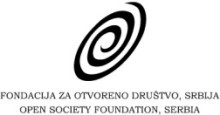
The views presented at the round table are the sole responsibility of the authors and do not necessarily reflect the views of the Open Society Foundation, Serbia.
-
PHOTO: MC Belgrade
-
PHOTO: MC Belgrade
-
PHOTO: MC Belgrade
-
PHOTO: MC Belgrade
-
PHOTO: MC Belgrade
-
PHOTO: MC Belgrade
-
PHOTO: ANEM
-
PHOTO: ANEM
-
No comments on this topic.
